| Alfred Evert |
25. September 2008 |
07.10. Typhoon - Turbine
(Download print version ap0710e.pdf 220 KB, 9 pages)
Whirlwind, Hurricane, Tornado, Cyclone, Typhoon
Atmospheric vortex systems are most impressive fluid-mechanical appearances, where hurricanes can take huge size, however also local whirlwinds can show enormous forces. If a proper trigger exists, these systems grow by ´self-organisation´ and produce autonomously accelerated flows. It should be possible to copy these ´natural machines´ by artificial devices and thus to produce autonomous running power stations. At the following, decisive effects are described and expedient conceptions are deduced. For differentiation from other machines and conceptions, following new type of engine is called ´Typhoon-Turbine´.
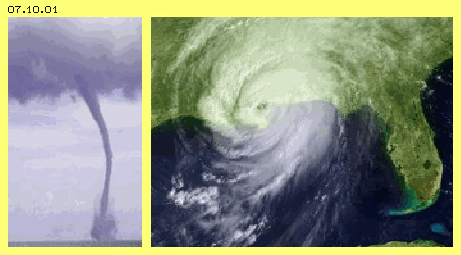 Tropical waters are heated and water evaporates, steam rised and up there cools down again. Turbulent flows and thunderstorms come up, steam condenses and heavy rains fall down. That thermodynamic process in general is considered to be causal for large hurricanes. However that movement pattern comes up also by only local dimension e.g. if cumulus clouds rise high up and fall down as cloudburst - without that heavy circling air movements all around. So evaporation of water and thermodynamic can only be a trigger, while real cause for acceleration of air-masses within wide environment is based on pure fluid-mechanic effect.
Tropical waters are heated and water evaporates, steam rised and up there cools down again. Turbulent flows and thunderstorms come up, steam condenses and heavy rains fall down. That thermodynamic process in general is considered to be causal for large hurricanes. However that movement pattern comes up also by only local dimension e.g. if cumulus clouds rise high up and fall down as cloudburst - without that heavy circling air movements all around. So evaporation of water and thermodynamic can only be a trigger, while real cause for acceleration of air-masses within wide environment is based on pure fluid-mechanic effect.
When previous steam rises at one place, also air is pulled upward and air of wide environment must flow to that place. Air never flows radial to a centre but builds inward turning vortex, at these huge vortices e.g. based on earth-rotation. As trigger for turning movement however will do even small asymmetries, e.g. of weak however contrary wind-flows. Also such ´dry´ whirlwinds can grow to mighty vortex-systems with its typical spiral inward turning air movements.
These ´potential-vortices´ are characterized by relative fast flows at centre, i.e. high dynamical (flow-) pressure there and corresponding reduced static (aside-) pressure (because sum of static and dynamical pressures is constant). Air of wide environment is resting or flows slower, so out there exist stronger static pressures. That pressure-gradient exists from quite outside towards vortex-core, so within total volume of vortex-system. These centripetal pressure-differentials thus exist between every ´flow-layers´, so compressing that vortex at any part of total system. Air is accelerated from outside towards core, moving at spiral inward curved tracks. Continuously more parts of static pressures are transmitted into dynamical pressures of faster flows.
That´s only and real cause for self-acceleration of vortex-systems, with air-movements up to sound-speed, no matter which trigger started system. This process works whenever neighbouring flows show different speeds (and thus different static pressures), no matter these vortex-systems have diameter of hundreds kilometre or only some metre - or even few centimetre.
Essential Characteristics
So at first, these vortex-systems need an original flow, a ´main-stream´, moving into longitudinal axis of vortex and turning around that axis. Trigger of tropical whirlwinds is that rising water-steam. Trigger of small whirlwinds might come up just by chance with local contrary air-movements, which mutually escape by upward-turning motions. Artificial ´imitation´ thus at first need an original twisting main-stream.
Second, that acceleration of flows is based on gradients of static pressures from environment towards vortex-core. From outside to centre, static pressure increasingly is transferred into dynamic pressure. Obvious effect of self-acceleration is based on aside-diagonal respective spiral inward-turning influx of ´wrong-air´ from most wide circumference all around. At natural whirlwinds, that influx is limited at bottom, so along ground most strong winds are racing. At machine-rebuild of that system, thus sufficient influx of ´wrong-air´ must be organized, so that vortex can achieve increasing angle-speeds along its longitudinal axis.
Finally that air must be allowed to flow off at end of vortex, otherwise system will collapse. Large hurricanes pile up huge air-masses for many kilometre, however system fades if these masses no longer can flow aside fast enough. At technical rebuild of that system, behind increasingly faster inward-turning vortex a following outward-turning vortex must be organized to take away air sufficiently fast, at its best back again to inlet of vortex.
No Pressing but Sucking
Within these machines must occur transmission of static pressure into dynamic pressure and continuous interaction of suction and pressure must take place. Viktor Schauberger all times pointed out, primary to apply suction. Enormous difference between pressing and sucking becomes obvious e.g. when air is transported through simple pipe.
Common formula tell, resistance depends on diameter and length of pipe, the more narrow and the longer, the more difficult throughput is. So it´s just a question of length until each pipe becomes self-closing system: no matter how strong air is pressed into pipe, at outlet flow will be null. Totally other result is achieved, if air is sucked off at end of pipe: nearby without resistance air flies through pipe, at nearby any diameter and any length, within bottlenecks up to sound-speed.
Application of pressure results contrary-pressure, friction- and heat-losses. Opposite, when using suction, any particle falls ´by itself´ into relative empty space. Fast flows are generated, simply because normal molecular motions are allowed to move into preferred direction. Without additional input of energy, particles fall forward and flows come up with speed of sound as maximum. So it will make sense to organize throughput within a machine prevailingly by suction, so given atmospheric pressure of environment becomes ´mobilized´.
At picture 07.10.02 upside left, previous three characteristic of whirlwinds schematic are shown: there must exist a trigger-flow A, which is accelerated in turning sense by influx B of additional ´wrong-air´. Finally air of that inward-curving vortex must flow off by an outward-curved vortex C.
At previous chapter ´07.09. Schauberger-Repuline´ movement processes of that ´legendary´ machine were analysed. Between their rotor-disks an outward-turning vortex exists, air practically is ´sucked off´ outward, because at larger radius wider space is available. However, suction by itself does not do anything, but motion into suction-area only comes up by existence of pressure respective higher density. At Repulsine, that main-stream and pressure and density at central inlet were produced by pumps respective also at openings for side-flows environmental pressure exists.
Based on previous considerations now it would make sense, at first to organize an inward-turning vortex, which is enforced by environmental pressure of wide area all around. That movement process is well known e.g. as ´bathtub-outlet-vortex´, see picture 07.10.02 upside right. There, gravity works as trigger. Analogue within a machine, closed circuit could be organized by sucking-off air at outlet of vortex, like marked at this picture at D.
Instead of disk-shaped rotor of Repulsine now advantageous would be used a rotor long-stretched. Around its longitudinal axis main-stream should twist and from wide cylindrical environment that influx of side-stream could accelerate and enforce inward-turning vortex. Finally at outlet of rotor an outward-turning vortex should take-off air sufficiently fast, e.g. by a pump continuously producing ´vacuum´ at rotor-outlet.
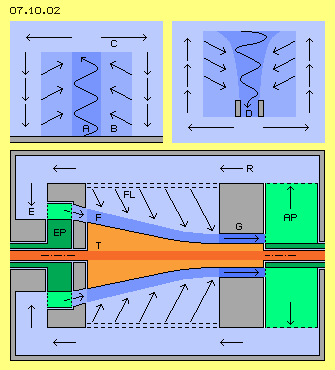 Heat plus Vacuum
Heat plus Vacuum
High-performance vacuum-pumps or fans are build by different constructions, however they show one common feature: they produce relative empty areas without energy-input. Air-particles fly ´by themselves´ into pump-inlet, where movable surfaces hit them towards pump-outlet. Inlet is ´empty´ again and some new particles, just by chance, are pushed into inlet by normal molecular motions. Area in front of pump-inlet thus becomes empty ´automatically´.
Energy-input is demanded only for that ´hit´ by which particles are pushed off. Particles become accelerated, i.e. waste-air becomes warm - and that surplus of heat-energy rather exactly corresponds to demanded energy-input for drive of pump (see data-sheets of common vacuum-pumps, a clear case of Perpetuum Mobile, because ´potential of vacuum´ is generated without power-input). Such pumps transform drive-energy into heat-energy and as additional side-effect they produce area of relative emptiness.
If warm waste-air is kept within system, that heat-energy won´t be lost. Heat is equal to faster speed of particles, i.e. stronger kinetic energy. Heat like this, naturally is also produced by pressure-pumps. However these pumps need more input because their output must be pressed into area of high density or static pressure. So these pressure-pumps must work counter strong resistance. Naturally also these vacuum- or suction-pumps must work counter resistance at output, however their exists only normal atmospheric pressure. And once more less resistance will exist, if waste-air is guided back, still turning within circuit of system.
Basic Conception
At bottom of picture 07.10.02 schematic are shown basic constructional elements of that conception, now drawn by horizontal axis. A cone-shaped turbine R (red) represents core of vortex. An inlet-pump EP (green) does not really affect pressure but only is guiding main-stream F (middle-blue) diagonal-forward towards surface of turbine. That twist-flow essentially is accelerated by influx of wrong-air FL from wide environment.
At G exists most dense flow (dark-blue) showing high angle-speed at short radius. Usable turning momentum results simply by friction of flows around turbine-surface. Essential drive for that machine is generated by outlet-pump AP (green), which maintains mass-throughput most economical. After that outward-turning vortex, air turns back via backflow-area R to inlet E. Major part of air however already will enter openings for side-stream and that wrong-air will compress and drive inward-turning vortex around turbine.
Typhoon-Engine
At picture 07.10.03 previous general conception is detailed and completed by some constructional elements. Decisive drive results of atmospheric pressure of environment. Thus housing GE (grey) may not be closed hermetic. Air of environment and from backflow R moves through inlet A towards inlet-pump EP (dark green). Its blades B (light green) transport air towards right and accelerate air in turning sense of system. That flow is guided through stator-fins C (blue) diagonal and some inward directed towards surface of turbine.
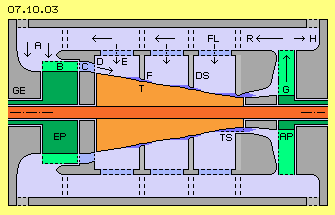 The turbine T (red) is build by cylinder in shape of round cone-trunk. Previous main-stream D rotates around that cylinder and wanders towards right, at spiral track with decreasing radius, finally towards turbine-outlet. Afterward, air is ´sucked-off´ by outlet-pump AP (green). Blades G (light green) take that air and transport it outward. Air by parts flows off system (see arrow H), e.g. for leading off surplus-heat. Main part of air however remains within system, moving through backflow-area R towards left, still turning.
The turbine T (red) is build by cylinder in shape of round cone-trunk. Previous main-stream D rotates around that cylinder and wanders towards right, at spiral track with decreasing radius, finally towards turbine-outlet. Afterward, air is ´sucked-off´ by outlet-pump AP (green). Blades G (light green) take that air and transport it outward. Air by parts flows off system (see arrow H), e.g. for leading off surplus-heat. Main part of air however remains within system, moving through backflow-area R towards left, still turning.
That backflow-area is build between two ´pipes´ (grey), which are fix parts of housing. Inner pipe has openings E (dark blue), through which wrong-air FL flows diagonal inward. Slow streams of backflow-area show stronger static pressure than flows further inside, turning increasingly faster towards turbine-surface. That relation of speeds thus corresponds to high static pressure of wide environment. Analogue to movement processes of whirlwinds, that ´typhoon´ around turbine-cone becomes accelerated.
Air-particles won´t fly outward based on centrifugal forces, but within that potential-vortex these particles are pressed inward based on centripetal pressure-gradient. Flows become accelerated and in combination with shorter radius rotation becomes faster and faster. As all particles move into similar directions, i.e. fly relative parallel to each other, these fast flows show high ´density´. So air through inlet-pump delivers only trigger of main-stream D, however side-stream of wrong-air FL results accelerating flow and increasing mass-throughput.
Additional acceleration could be achieved by nozzle-effect. For that, space around turbine is divided into several sections by stationary ´nozzle-disks´ DS (light grey). Between each disks and turbine-surface a bottleneck F is build, within which known acceleration comes up (see dark blue areas).
Turning momentum is generated by friction at smooth round surface of turbine, e.g. especially at areas of these bottlenecks. Only direct at turbine-outlet additional turbine-blades TS could be installed (like drawn downside of turbine at longitudinal cross-sectional view, as an alternative). Different to common flow-machines, not total kinetic energy might be drawn off system, but only by parts that energy resulting of self-acceleration of that whirlwind. At the following some elements are discussed some more precise.
Wrong-Air Effect
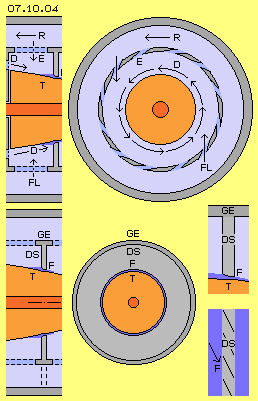 Picture 07.10.04 upside left once more shows part of previous longitudinal cross-sectional view and upside right corresponding cross-sectional view. From turbine-inlet comes main-stream D which spiral flows around turbine-cone toward right. From backflow-area R enters wrong-air FL through openings E.
Picture 07.10.04 upside left once more shows part of previous longitudinal cross-sectional view and upside right corresponding cross-sectional view. From turbine-inlet comes main-stream D which spiral flows around turbine-cone toward right. From backflow-area R enters wrong-air FL through openings E.
Air within backflow-area moves and rotates slower that central stream. Out there thus exists stronger static pressure than near turbine-surface. Particles of wrong-air are pressed inward and ´disappear´ into main-stream and as they move up to sound-speed, main-stream becomes accelerated. Towards right side, space around turbine becomes wider, so even more environmental pressure can work. At the other hand, towards right side circumference of turbine decreases, so angle-speed increases. Within that machine a whirlwind is rebuild inclusive its known self-acceleration.
Nozzle-Effect
At natural whirlwinds, ´wrong-air´ flows spiral towards core of vortex. At ground no further influx is possible from bottom, that´s why most heavy storms race along that ´border-face´. Analogue within that machines, artificial borders could be installed in order to rebuild that ´ground-effect´, even multiple by previous mentioned ´nozzle-disks´.
At bottom of this picture 07.10.04 area of a nozzle-disk is sketched, left side again by longitudinal and at the middle by cross-sectional view. Nozzle-disk DS (light grey) is fix part of housing GE (dark grey). That disk reaches near surface of turbine T (red), so there building a bottleneck F all around. Within that area (marked dark blue) left side, air is dammed-up somehow, i.e. is hindered in its axial movement for the benefit of faster rotation. Based on known nozzle-effect, accelerated stream will flow off bottleneck towards right.
Quite right side, by some larger scale, cross-section of nozzle-disk DS is drawn, where bottleneck shows wedge-shaped cross-section. Accelerated stream should not run only in axial direction but preferably into turning sense of system. Diagonal positioned ribs at inner face of nozzle-disk (see sketch at bottom right side) could be installed in order to guide that stream at wanted spiral track.
Only by test can be determined, whether and how many nozzle-disks will be optimum, how small bottlenecks should be and how turbine-surface there will show optimum contours. Possibly also ram-effect could be used if bottleneck by parts is totally closed. Also inclination of turbine-cone will be determined only by tests, some sections might be inclined more steep and others more flat. Probably turbine even could show likely radius throughout.
Teeth-shaped Turbine-Blades
Within that flow-machine, air will move by different speeds at different areas, however air must steady move within total circuit. Turning momentum might be drawn off system only by parts of energy generated by self-acceleration effects of inward-turning vortex. Probably turbine drive is sufficient only by friction of air at its surface, especially within area of previous bottlenecks.
At turbine-outlet one last time should be build such a bottleneck and afterward air is guided into backflow-area by that outlet-pump. That turbine will show round surface and only direct at its outlet might be installed additional turbine-blades. Suitable shape of blades is described at the following..
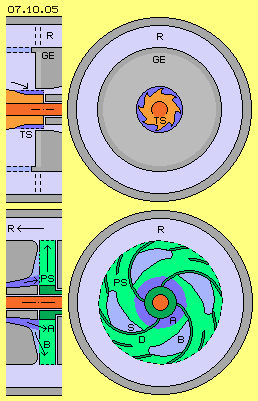 Picture 07.10.05 shows section of turbine-outlet, upside left by longitudinal and upside right by corresponding cross-sectional view. Housing GE (grey) reaches nearby at surface of turbine T (red), which there has its smallest radius. Within that turbine-surface could be engraved some deepenings, starting diagonal and passing into axial direction. These ´blades´ thus are curved some backward (in turning sense), so flow becomes redirected and turning momentum is generated.
Picture 07.10.05 shows section of turbine-outlet, upside left by longitudinal and upside right by corresponding cross-sectional view. Housing GE (grey) reaches nearby at surface of turbine T (red), which there has its smallest radius. Within that turbine-surface could be engraved some deepenings, starting diagonal and passing into axial direction. These ´blades´ thus are curved some backward (in turning sense), so flow becomes redirected and turning momentum is generated.
Momentum is only produced at pressure-side of any turbine-blade (showing backward in turning sense), while alongside ´suction-side´ air also flies ´around the corner´, however without affecting pressure. Suction-sides of turbine-blades thus are not productive respective superfluous. If deepenings within turbine-surface are shaped like asymmetric teeth, total flow is redirected only by pressure-sides. Air-particles hit direct at steep flank of tooth and are redirected there or particles fly over flat flank and hit finally at next steep flank.
At this picture upside right these tooth-shaped contour of turbine-blades TS (light red) is sketched. Open cross-section of turbine-outlet is marked dark blue. Details to asymmetric tooth-blades are described at several chapters of that website.
Spiral-Canal-Suction-Pump
This picture 07.10.05 at bottom shows section of outlet-pump, again by longitudinal and corresponding cross-sectional-view. That pump has to create relative ´emptiness´ so no tailback into turbine-outlet exists. That pump well could be oversized, in worse case it will run party ´idle´ with few energy-demands. Common vacuum-pumps or fans could be used, however conception described in chapter ´05.11. Spiral-Canal-Pump´ at the meantime proved to be most effective.
Intake of air into a pump can not be forced, but pump can only offer any space into which particles fly by themselves. That inlet-opening respective flow A here is marked dark blue. Pump-blades PS (at cross-sectional view marked dark green) should strongly be curved backward in turning sense, so rotating surfaces will hit particles outward. Here for example, four such blades are drawn, outside completed by some short blades.
Each pump-blade has a pressure-side D (frontside in turning sense) and a suction-side S (backside in turning sense). Only at pressure-side the particles are pushed off by energy-input and only along that face, air is relative dense (because surface follows that air). Opposite, suction-side all times is running off from air, thus continuously generates ´emptiness´. If in addition that pump shows constant width (like drawn here), increasing space is available for these air-masses.
Left side-wall of that pump shows additional openings, each along suction-side of blades, however only at middle radius. Thus possibility is offered for air-particles to fall ´by themselves´ (i.e. based on collision of normal molecular movements) into that relative empty space. Particles follow that back-moving surface up to sound-speed. These openings respective flow B here are marked light blue. That spiral-canal-pump achieves increased mass-throughput - without corresponding additional energy-input.
Control
Previous pictures show version of that ´Typhoon-Engine´, where turbine is installed at a long shaft and input- like output-pumps are installed at separated hollow-shafts. Each component can drive different revolutions. Machine thus could be controlled via revolutions of pumps.
The input-pump must produce a ´main-stream´, the faster turbine turns the faster that flow must be. The output-pump in general should be oversized, so also this component could run as fast as turbine. If capacities are well coordinated, thus all three components well could be installed at one common shaft.
That machine must drive high revolutions e.g. of 30000 rpm. Long shafts tend to swinging motion and are difficult to handle. As an alternative, each pump could have an electric-motor integrated and also direct within turbine an electric-generator could be included. Cooling would make no problem as any air flow is available. Rotating parts should be mounted ´contactless´ e.g. magnetic respective these elements anyway will ´swim´ within air-cushions. As all turning parts show short radius, these high revolutions will be possible.
Turning momentum of turbine is based on self-acceleration of potential-vortex, which is caused by influx of air from environment. Performance of turbine thus depends on air-masses of that ´wrong-air´. For control of machine thus decisive is, these wrong-air-openings (marked E at previous pictures 07.10.04 and 07.10.05) must have variable cross-sectional surfaces. This is done e.g. by ring-shaped cover shiftable into axial directions or any kind of controllable valves (here at drawings not shown).
Atmospheric air-pressure represents most strong static pressure for that machine, so engine may not be hermetical closed but must show openings towards environment. At the other hand these openings at housing are necessary for balancing possible heat-surplus. So also these openings should have variable cross-sectional surfaces.
Data
Up to now I did not dare to suggest constructions with these high revolutions (because too expensive and difficult for hobby-craftsmen). Here however turning elements show radius for example of only 8 cm to 16 cm. If turbine-outlet has radius of 8 cm and turbine drives previous 30000 rpm, previous turbine-blades will move by about 250 m/s within space. If tooth-blades show height of about 1 cm, cross-sectional surface of output is about 30 cm^2. If air would flow off by sound-speed, mass-throughput by scale of about one cubic metre each second would result.
If backflow-area is arranged e.g. between radius of 18 cm to 21 cm, cross-sectional surface of about 360 cm^2 is available. Air will move there thus twelve time slower resp. by less than 30 m/s. Only once more stated: at resting air and at these moderate speeds and at sound-speeds, particle in principle move likely fast by about 500 m/s. Only vectors of all motion show into any direction, or some forward, or prevailingly forward directed, or when air is falling into relative emptiness particle move nearby parallel and one near next.
So real kinetic energy of air-movements at any case is constant, like sum of static plus dynamic pressures is constant. Air within backflow-area shows much higher static-pressure-part than fast running air near turbine-surface, corresponding e.g. to that relation of 30 m/s to 330 m/s (and that relation by square). That pressure-gradient drives acceleration of inward curved spiral motion. That structured flow is ´destroyed´ by friction at turbine-surfaces and especially by redirection at turbine-blades resp. that thrust affects usable turning momentum - without diminishing general motion-speed of all air-particles (in reality, particles become some slower when hitting on back-stepping pressure-side of turbine-blades and particles become some faster by hit of pressure-side of pump-blades).
As long as flow-data within that Typhoon-Engine are not exactly known, no reliable statements are possible concerning performance of that motor (like in general exact power of turbines is only known by empirical measurements). So following consideration may only give a clue.
Potential-vortices can self-accelerate, theoretical up to sound-speed of about 330 m/s. Maximum speed within that machine for example could be 275 m/s. Only some tenth of kinetic energy of that flow should be drawn off system. So at outlet of turbine flow should show e.g. 250 m/s. Turbine-blades thus affect pressure contrary to existing flow by size of about 25 m/s. That pressure is calculated by P = 0.5 times density times speed-by-square, thus would result P = 0.5 * 1.2 * 25*25 = 375 N. That force works at radius of previous 8 cm, so turning momentum M = 375 * 0.08 = 30 Nm would result. That´s rather few in comparison with common engines, however that motor runs relative fast. Performance of rotating systems is calculated by formula P = M * n / 9550, so here P = 30 * 30000 / 9550 = 94 kW.
That gross-performance is reduced by energy-input for pumps and losses of friction and efficiency of all components. At the other hand, performance increases by square of speeds. That engine could show diameter of about 45 cm and inclusive generator and motors and control-units could show length of 1 m. Besides these assemblies nothing else than just normal air that device contains - nevertheless will show usable size of performance. So it seems just realistic as an American company prepares similar engines with wide range of performance, e.g. also for drive of cars.
The Aerodynamic Air Turbine Engine
This year, ´Rockwell-Scientific-Research, L.L.C.´ caused quite a stir with some publications and website ´www.airturbineengine.com´. There is told about an ´Aerodynamic Air Turbine Engine´ - based at ´Vortex Implosion Technology´ with reference to Viktor Schauberger. However neither general conception nor technological information are published, instead of some mysterious occurrences and diverse expectations are mentioned. So as usual, these statements should be viewed with scepticism.
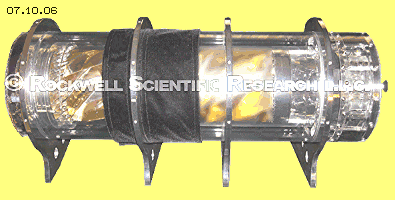 By that information, real inventor was Haskell Karl, who showed running machine already in 1960. Finally in 2005 Ron Rockwell did take that idea and already one year later, first motor did function. In the meantime, diverse versions were developed, e.g. with transparent materials for study of flows. Now machines are prepared ready for production - and one might wait to see.
By that information, real inventor was Haskell Karl, who showed running machine already in 1960. Finally in 2005 Ron Rockwell did take that idea and already one year later, first motor did function. In the meantime, diverse versions were developed, e.g. with transparent materials for study of flows. Now machines are prepared ready for production - and one might wait to see.
Presented photos (see picture 07.10.06) intentional are unsharp and decisive section is protected. Nevertheless I was enthusiastic immediately because I saw some of my considerations confirmed. Naturally that machine could be build by quite other principles, at the other hand literally is stated: ´a tornado is created in the engine that implodes on itself which actually speeds up and sustains the airflow back into the tornado´.
Thus my detailed descriptions of flow-processes and general demanded constructional elements of previous ´Typhoon-Turbine´ well could fit with that announced machine. At any case now it´s obvious, research and development into that direction make sense.
The Crystal Ion
This additional name is called aptly for ´The Advanced Aerodynamic Air Turbine Engine´ (AATE), however not explained why. If turbine should be used directly as rotor of integrated generator, magnetic fields are rotating, which well could result ionization of air particles. However in general, most strange appearances can come up if machines rotate by these high revolutions - up to ´levitation´.
By my understanding, material parts are local vortices-systems of ether within gapless ether. If these vortices are guided around system axis by high revolutions, all ether all around is involved strongly. Resulting of are overlaying turning motions, an extreme ether-conform motion-pattern. Then, as well known, spin of all atoms becomes structured in likely sense. That happens with atoms of solid material of machine and naturally also for gas-masses.
Likely directed spin reduces ´chaos´ of normal air movements and thus results flows even better structured. That effect could be enforced e.g. by magnets installed at housing-walls and nozzle-disks cross to influx of wrong-air.
When air rotates around turbine at spiral tracks and same time all particle rotate likely around their axis, border-layer (of ether) around turbine-surface is ´brushed´ by motion-pattern which corresponds to electric flow. Like known by N-machines, thus turbine by itself could be uses as electric conductor, here e.g. in shape of an endless-coil.
However, detailed descriptions of my understanding of ether as background of ´material´ appearances will take many further chapters of Ether-Physics. Until then, my previous suspicions concerning that ´Crystal Ion´ are pure speculation. Anyway: pure fluid-mechanical processes now are known sufficiently, so that ´Typhoon-Turbine´ can be build - even without ´Crystal Ion´.
At the one hand, one can understand why companies don´t publish details premature. If however an invention is claimed to be global solution for energy-problems in total, demands are huge and it would make sense, many companies and institutes immediately could contribute efforts for research and production. Now sufficient facts are on the table, just for free, so anyone might start.
 Tropical waters are heated and water evaporates, steam rised and up there cools down again. Turbulent flows and thunderstorms come up, steam condenses and heavy rains fall down. That thermodynamic process in general is considered to be causal for large hurricanes. However that movement pattern comes up also by only local dimension e.g. if cumulus clouds rise high up and fall down as cloudburst - without that heavy circling air movements all around. So evaporation of water and thermodynamic can only be a trigger, while real cause for acceleration of air-masses within wide environment is based on pure fluid-mechanic effect.
Tropical waters are heated and water evaporates, steam rised and up there cools down again. Turbulent flows and thunderstorms come up, steam condenses and heavy rains fall down. That thermodynamic process in general is considered to be causal for large hurricanes. However that movement pattern comes up also by only local dimension e.g. if cumulus clouds rise high up and fall down as cloudburst - without that heavy circling air movements all around. So evaporation of water and thermodynamic can only be a trigger, while real cause for acceleration of air-masses within wide environment is based on pure fluid-mechanic effect. Heat plus Vacuum
Heat plus Vacuum The turbine T (red) is build by cylinder in shape of round cone-trunk. Previous main-stream D rotates around that cylinder and wanders towards right, at spiral track with decreasing radius, finally towards turbine-outlet. Afterward, air is ´sucked-off´ by outlet-pump AP (green). Blades G (light green) take that air and transport it outward. Air by parts flows off system (see arrow H), e.g. for leading off surplus-heat. Main part of air however remains within system, moving through backflow-area R towards left, still turning.
The turbine T (red) is build by cylinder in shape of round cone-trunk. Previous main-stream D rotates around that cylinder and wanders towards right, at spiral track with decreasing radius, finally towards turbine-outlet. Afterward, air is ´sucked-off´ by outlet-pump AP (green). Blades G (light green) take that air and transport it outward. Air by parts flows off system (see arrow H), e.g. for leading off surplus-heat. Main part of air however remains within system, moving through backflow-area R towards left, still turning. Picture 07.10.04 upside left once more shows part of previous longitudinal cross-sectional view and upside right corresponding cross-sectional view. From turbine-inlet comes main-stream D which spiral flows around turbine-cone toward right. From backflow-area R enters wrong-air FL through openings E.
Picture 07.10.04 upside left once more shows part of previous longitudinal cross-sectional view and upside right corresponding cross-sectional view. From turbine-inlet comes main-stream D which spiral flows around turbine-cone toward right. From backflow-area R enters wrong-air FL through openings E. Picture 07.10.05 shows section of turbine-outlet, upside left by longitudinal and upside right by corresponding cross-sectional view. Housing GE (grey) reaches nearby at surface of turbine T (red), which there has its smallest radius. Within that turbine-surface could be engraved some deepenings, starting diagonal and passing into axial direction. These ´blades´ thus are curved some backward (in turning sense), so flow becomes redirected and turning momentum is generated.
Picture 07.10.05 shows section of turbine-outlet, upside left by longitudinal and upside right by corresponding cross-sectional view. Housing GE (grey) reaches nearby at surface of turbine T (red), which there has its smallest radius. Within that turbine-surface could be engraved some deepenings, starting diagonal and passing into axial direction. These ´blades´ thus are curved some backward (in turning sense), so flow becomes redirected and turning momentum is generated. By that information, real inventor was Haskell Karl, who showed running machine already in 1960. Finally in 2005 Ron Rockwell did take that idea and already one year later, first motor did function. In the meantime, diverse versions were developed, e.g. with transparent materials for study of flows. Now machines are prepared ready for production - and one might wait to see.
By that information, real inventor was Haskell Karl, who showed running machine already in 1960. Finally in 2005 Ron Rockwell did take that idea and already one year later, first motor did function. In the meantime, diverse versions were developed, e.g. with transparent materials for study of flows. Now machines are prepared ready for production - and one might wait to see.